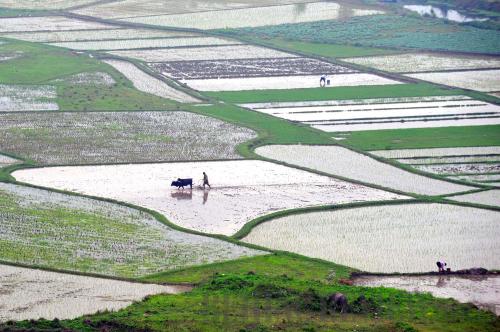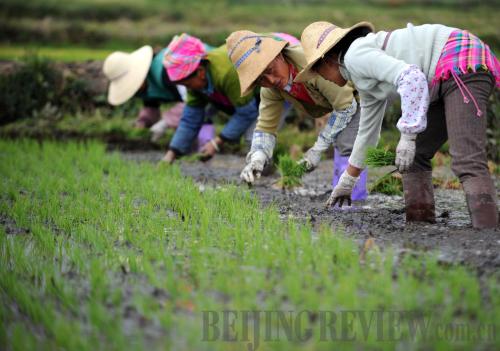|
 |
|
HOPE OF HARVEST: Farmers in Liujiang County in Guangxi Zhuang Autonomous Region plow the plots for rice seedlings on May 1 (HUANG XIAOBANG) |
Ensuring steady growth in grain production and farmers' incomes was a primary concern among officials and experts at an April 20 seminar on China's rural economic prospects.
Changes in farmers' net incomes in recent years indicate the income gap between farmers in east, central and west China is narrowing. The gap between urban and rural residents, however, has widened further, said the Rural Economy 2009-10 Green Paper jointly released by the Chinese Academy of Social Sciences and the National Bureau of Statistics at the seminar.
The income gap between urban and rural residents will expand to a ratio of 3.35:1 this year, the Green Paper said. Local governments at all levels will have to step up efforts to maintain the high growth momentum of the rural economy, especially given the ongoing drought in China's southwestern region that started last September, it said.
China is still a developing country largely reliant on its agricultural base. Its ability to properly address issues in the agricultural sector, such as product price fluctuations, agricultural imports and exports, rural employment and rural income increases, will not only directly affect this year's economic growth, but also concerns the appropriate handling of such problems as inflation and the building of a harmonious society.
Grain growth difficulties
"It's going to be difficult to reap another harvest that's greater than last year's," said Zhang Hongyu, Director of the Industry Policy and Law Department under the Ministry of Agriculture.
China has sustained grain production growth for six consecutive years, and its grain output has exceeded 500 million tons for three consecutive years. These have provided the country with sufficient grain reserves and a guarantee of stable grain supply this year, Zhang said, adding that price hikes are unlikely in the domestic grain market this year.
But price increases for agricultural products, estimated at around 4 percent, can be expected due to periodic fluctuations of agricultural product prices, changes in China's grain-related policies and the impact from international price hikes of agricultural products, he said.
While all aspects of agricultural production will be put to the test this year, grain production stands out as a major challenge to China's agricultural sector, Zhang said.
Despite China's ability to sustain grain production growth in recent years, the per-capita output has never exceeded the record high of 206 kg set in 1998. The per-capita grain production last year stood at only 199 kg.
China strives to produce 550 million tons of grain annually, however, it remains a formidable challenge this year because of unpredictable losses caused by the drought in the southern region, Zhang said. Low temperatures that replaced traditionally warmer spring conditions in the northern region have also plagued grain production.
Weak competitiveness
Some worry that large imports of agricultural products will deal a heavy blow on China's agricultural sector, especially after China secured WTO membership in 2001. The Green Paper also pointed out China's agricultural products have yet to gain a competitive edge at the global market despite rapid increases in exports.
Exports of agricultural products increased 14.3 percent annually from 2003 to 2007, making China the world's fifth largest agricultural exporter, said the Green Paper. The growth, however, is largely due to growing demand for agricultural imports worldwide, which grew at an average rate of 13.6 percent during this period.
Fundamental changes have yet to take place in problem areas including small production scales, low-quality labor and low production efficiency that have prevented China's agricultural sector from increasing its competitiveness globally, said the Green Paper.
Primary products account for the majority of China's agricultural exports. Statistics from the Ministry of Commerce said processed agricultural products accounted for only 24.3 percent of China's agricultural exports last year.
Of all products, cotton and soybean were impacted the most in the international competition.
China relies heavily on imports to fulfill its cotton demand, bringing in 2.62 million tons in 2007 and 2.19 million tons in 2008. Domestic production during those years could only supply 63 percent and 58 percent respectively.
One major reason for China's increasing reliance on imported cotton is the country's less competitive cotton production among global competitors, said the Green Paper. From 2003 to 2007, China's cotton production was weakened because of the low application rate of agricultural equipment, small planting scales, increased labor costs and the appreciation of the renminbi.
Key issues
 |
|
BUSY SEASON: Farmers in the Dali Bai Autonomous Prefecture, Yunnan Province, are busy planting rice seedlings, taking advantage of the recent odd rainfall (QIN QING) | Experts at the seminar focused their discussion on several challenges facing the development of the rural economy.
First and foremost, said Li Zhou, Deputy Director of the Institute of Rural Development under the Chinese Academy of Social Sciences, is the inequality in transactions of farmland.
Currently, while converting farmland into all-purpose land some local governments have cut corners in abiding certain laws and regulations, giving rise to many conflicts between local governments and farmers. Often the case, local governments reap huge profits by purchasing land from farmers and selling the property at a grossly inflated price. Local governments have also been known to ally with profit-oriented entrepreneurs to seize farmland, in the name of attracting investment to benefit the local residents.
Li suggested the Central Government introduce a regulation to curb such illegal land transactions and then push on relevant legislative efforts.
Urban-rural integration was another concern brought up at the seminar. Lowering the threshold for securing an urban hukou, a resident permit distributed by the Chinese Government, to allow more farmers to become urban residents would help promote China's urbanization process and increase the efficiency of urban development, experts said.
But lowering the threshold won't completely solve the urban-rural integration problem. As more cities adopt the practice, it will only differentiate successful farmers who secure an urban identity from those who have not, said Li.
A more appropriate practice would be making full use of the comparative advantages of the countryside and allowing China's vast rural areas to develop. This would help fill the urban-rural gap, he said.
"There are already a number of examples of villages that have achieved prosperity on their own. Whether you have an urban or rural hukou makes no difference," Li said. "Their emergence in large quantities will help promote the maturity of new systems while pushing aside old ones."
During this process, the government must provide equal accesses to public facilities and services, and create favorable conditions for more villages and towns to overcome the welfare gap between urban and rural residents caused by the hukou registration system, he said.
Securing financing for agricultural production has also been a daunting task.
Capital—what China's countryside lacks most—is necessary to spur the development of the country's vast rural areas. And regulations by the Central Government and the State Council, in this regard, have not effectively changed the fact that capital outflow is bigger than inflow in rural areas, said Zhao Yang, an official with the Office of Central Rural Work Leading Group.
"In 2007, net capital outflow in rural areas under county jurisdiction totaled 1.22 trillion yuan ($178.6 billion), and there has been no noticeable change to this situation in years," Zhao said.
While some local governments have abided by the policy that requires loans based on new deposits in rural areas be granted to farmers, other local authorities have been quick to cut corners, Zhao said.
Zhao recently visited Xinyang, an agriculture-oriented city in Henan Province with a population of 8 million and a pilot area for rural reform experiments in the province. Xinyang has been actively exploring new models for rural financing through rural credit cooperatives and other cooperative organizations.
"Their goals are completely within their reach if they steer efforts in the right direction," he said.
During this trip, Zhao noticed that after more than one year of system innovations and adjustments, the loan-to-deposit ratio for increased deposits and loans exceeded 100 percent in the majority of counties in Xinyang.
"They not only granted new deposits in the form of loans to promote the development of the countryside and agricultural production and bring up the income of farmers, but also increased loans from other sources. The loan-to-deposit ratio based on increased deposits in Xinyang as a whole exceeds 70 percent," Zhao said.
| 